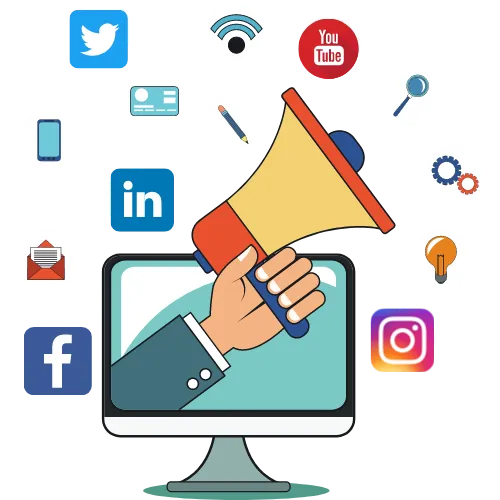
The Community Manager is more than the person in charge of publishing content on Facebook, Twitter, Instagram or any other social network your company has.
Therefore, below we will tell you what are the functions of the Community Manager, why it is important their participation in the company and we will also tell you why you need one in your business.
What is a community manager and who can be one? 🤔
Being a Community Manager, or in charge of managing social networks, is a very complex profession that requires different skills and competencies.
Currently the profession of Community Manager is being highly sought after as companies are realizing that they need someone who is solely responsible for the management of their social networks, since most internet traffic is being done through this medium.
Nowadays, there are many ways to acquire the skills that every good Community Manager needs: whether you get them on your own or empirically. In fact, if you are a genius at managing your personal social networks, you may already have some experience, although it is not at all advisable to launch yourself as a Community Manager with only the knowledge of managing your personal accounts.
In order to hone your skills it is highly recommended that you train yourself by taking courses on the subject; in fact, online you will find a wide variety of online sites dedicated to this particular topic that will give you certifications and all the knowledge you need to efficiently perform your role as Community Manager within your company.
As a first instance, one of the necessary requirements to be a professional Community Manager is to demonstrate passion for social networks. In addition, it is important to have good empathy, develop creativity and ingenuity, as well as the ability to establish relationships through the Internet.
Along with the above, an experienced Community Manager will have the following capabilities:
● Community management.
● Crisis management.
● Customer service.
● Copywriting.
● Storytelling.
● Knowledge of Facebook Ads.
● Among other things.

Personal Branding.
When starting a resume as a Community Manager, you will not only need to have a broad knowledge of the tools we have already mentioned. It is important to acquire experience performing day to day in the administration of social networks, in order to generate your own personal brand.
Undoubtedly, the best recommendation is, at first, to work on yourself and manage your personal brand.
Create your own page in networks, separating it from your personal account, to generate community and generate content for it, since in this way you will gain experience in the management of networks; in fact, creating and managing a successful personal brand is an ideal ally when testing your resume.
Of course, manage your personal brand in the most professional way you can and apply the knowledge you would apply to a company account.
You can take your first steps as a community manager by creating your personal brand. First steps:
First things first. To get started as a Community Manager, you have to create the account you are going to work on (in case you don't have one). You will have to establish a user name and fill in a description.
In the description you should be direct and clear about your brand. It is important to accompany your content with a visual element, such as an image or video, so you will have to consider the publication guidelines of each social network to adapt the visual content, since each one handles different formats.
Social networking platforms. ✏
Nowadays there are several social networking platforms, but companies focus on the main ones or the most popular ones according to their audience, so we are going to name some of them and their main features.
Twitter: Es la segunda red social más grande del mundo, te permite realizar post de texto, imagen, vídeo y encuestas, podrás hacer uso de geolocalización, hashtags y colocar Trending Topics.
Facebook: It is the most used social network and the largest in the world, in it you can make posts in text, images, stories and video, you have the opportunity to have reactions, allows geolocation and what attracts the attention of companies is the use of ads.
YouTube: It is the second most used search engine in the world (after google), one of its advantages is that it filters its content by categories, allows subscriptions to its channels and for interaction it offers likes, comments and shares.
Instagram: is a social network based on photography and video, it allows the post in photo or video format, you can use hashtags, geolocation and like Facebook you can create paid exposure campaigns.
LinkedIn: It is a professional and business network, that is to say, it is a social network with more formality and seriousness if you want to form a business network, this is the right social network, it allows interaction through comments, likes and mentions.
#Hashtags. 😌
What do hashtags mean? The use of this term was born in twitter, but was adapted by Facebook, Pinterest and Instagram, so today these hashtags are present in all social networks.
They are used to create topics of conversation and concentrate them, that is to say when you enter the link of a hashtags you will see all the publications that are using it, so it is important that when you create a hashtags, it must be concrete, short and above all that has a neutral language for many people from different places are involved in the conversation, hashtags are created all day and those trends on twitter and Instagram can be tracked pro through hashtags.
The use of #Hashtags can be of great help in grouping Content Creation topics.
Is it possible to use the same content on all social platforms? No, since it is important to mention that each social network has certain characteristics that differentiate them.
The above must be taken into account when creating content, since each platform requires different formats and sizes for uploading multimedia content.
You may, at some point, have thought that a piece of content is good for Twitter, but upon deeper analysis it ultimately sticks more closely to the format of a post for Instagram.
It is also important to know in depth the variety of content that you can publish in the different social networks in which you will work: along with the traditional publications and photos and videos, a variety of networks already allow live videos, video premieres (such as Facebook and Youtube), videos shared in groups, filters for photos (Instagram) or the opportunity to monetize your videos (if you are looking for that field), and even generate business networks with companies or people dedicated to the business as in the case of LinkedIn. You can even monetize such content and start generating income through your content.
It is also important to consider engagement, that is, the link you want to generate with the public or community with which you are communicating or with which you want to communicate.
To do this, your content should arouse the curiosity of the audience with your publications. Seek to generate a following, or follow, so that they consume your brand's content, providing something of interest to the community.
The creation of content is only part of the work of the Community Manager, since it is also important to mention that he/she will be in charge of answering questions from the community, so he/she must also have an excellent spelling and extensive knowledge about the brand or company so that the answers are concrete and concise.
Social media performance and statistics. 😬
Do you know how you are performing on social networks? You'll be happy to know that social media statistics exist.
Analyzing this data will be the best way to know if your digital marketing objectives are being achieved, or if it is time to change your strategy.
Here are the social media statistics that a community manager should know how to read.
Each of your social accounts will include by default its own metrics and it is necessary that the person in charge of managing the social networks knows which are the most important to evaluate the strategies.
Facebook insights. 📈📉
Facebook statistics are known as Facebok Insights, which you can find in the top bar of the fan page, it is important to know that to see these metrics you must be an administrator of the page.
This data is based on metrics that relate to each of your publications.
The main statistics to pay attention to in Facebook Insights are:
Reach: which will indicate how many people have seen your publication.
Comments: which will show how many comments your post has received.
Likes: here you will be able to see the interaction of reactions to your publication.
Clicks: Here you will see the number of times users have clicked on your posts, discarding likes and shares.
Shares: will indicate the number of times your post has been shared.
Facebook Insights will help you see how your fan page is performingTwitter Analytics.
Twitter also has an option to view your metrics natively called Twitter Analytics. In it you have the option to check information about the performance of the account for the last 28 days.
One of the most interesting data you can find here is the number and impressions of each of the tweets, this will indicate the effective reach of each of the publications, also Twitter offers to see the individual statistics of each publication, to open this option you just have to press the analytics icon that is available in each post.
The most important metrics that you will be able to consult in Twitter Analytics are:
Retweets: which will indicate how many times the publication has been shared.
Favorites: here you will see the number of times a tweet has been marked as a favorite.
Responses: Here you will see how many replies your posts have received.
With Twitter Analytics you review the performance of your tweets.
In this social network you will find one of the most relevant metrics, as it is a social network dedicated to the world of work and business, you will have access to know the performance of individual accounts, for this you only have to consult the option "Who has seen your profile" in the profile tab within the same site.
Main LinkedIn metrics in the individual profile:
Profile views: Here you can see the number of times people have viewed your profile during the last 90 days.
Actions performed: here you can see the number of times you have generated interaction (comments, recommendations, likes and times you have added contacts).
Data on who visited your profile: This section tells you how many people have viewed your profile, but details the jobs they have.
As you can realize the Community Manager can be an important part of the company, as it will not only focus on uploading content related to the brand or share memes that generate laughter from the audience, the work of the Community Manager goes beyond that as it is who will be responsible for your brand, to express the values of this, He will attend your customers and will offer them that customer service that today is very sought after in networks, also touching this topic and if you are looking to offer a Community Manager service even more profiled you should know that you can seek training in ads so that you have a more complete service for the company.
Now that you know the importance of a Community Manager you will realize why you need one in your company, remember that a social media professional is someone who does more than just share images on Facebook.

